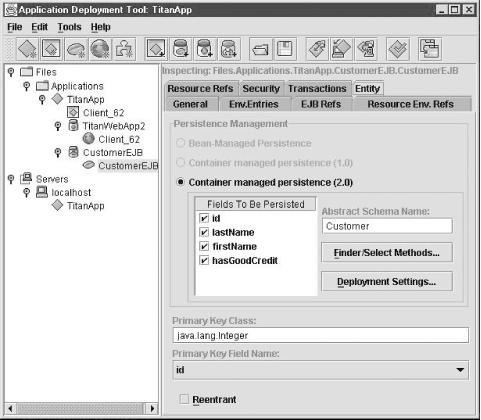The Customer EJB
In the following example we will develop a simple CMP 2.0 entity bean—the Customer EJB. The Customer EJB models the concept of a cruise customer or passenger, but its design and use are applicable across many commercial domains.
As the chapter progresses, the Customer EJB will be expanded and its complexity will increase to illustrate concepts discussed in each section. This section serves only to introduce you to the entity bean and some basic concepts regarding its development, packaging, and deployment. To simplify things, we will skim over some concepts that are discussed in detail later in the chapter.

Figure 6-3. J2EE 1.3 SDK deployment tool
The Customer Table
Although CMP 2.0 is database independent, the examples throughout
this book assume that you are using a relational database. This means that we
will need a CUSTOMER
table from which to get our
customer data. The relational database table definition in SQL is as
follows:
CREATE TABLE CUSTOMER
(
ID INT PRIMARY KEY NOT NULL,
LAST_NAME CHAR(20),
FIRST_NAME CHAR(20)
)The CustomerBean
The CustomerBean class is an abstract class that will be used by the container tool for generating a concrete implementation, the persistence entity class, which will run in the EJB container. The mechanism used by the container tool for generating a persistence entity class varies, but most vendors generate a subclass of the abstract ...
Get Enterprise JavaBeans, Third Edition now with the O’Reilly learning platform.
O’Reilly members experience books, live events, courses curated by job role, and more from O’Reilly and nearly 200 top publishers.

